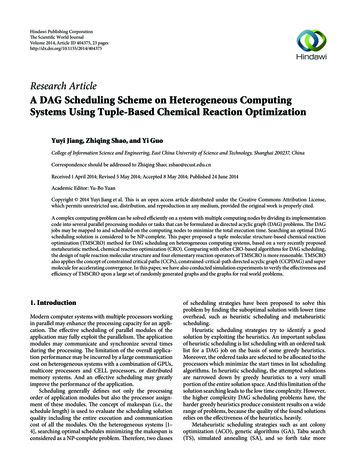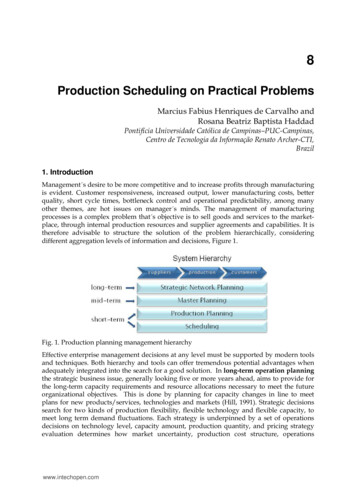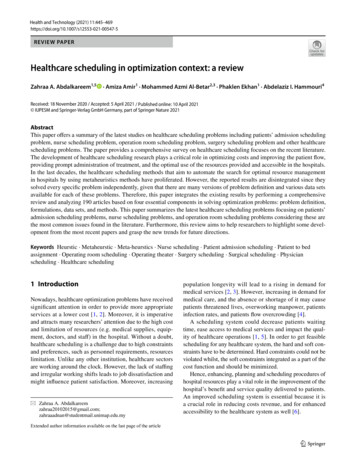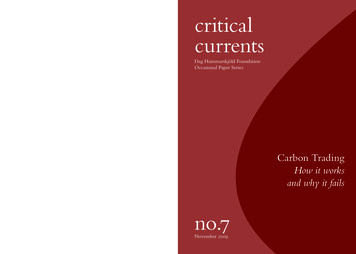
Transcription
Hindawi Publishing Corporation e Scientific World JournalVolume 2014, Article ID 404375, 23 pageshttp://dx.doi.org/10.1155/2014/404375Research ArticleA DAG Scheduling Scheme on Heterogeneous ComputingSystems Using Tuple-Based Chemical Reaction OptimizationYuyi Jiang, Zhiqing Shao, and Yi GuoCollege of Information Science and Engineering, East China University of Science and Technology, Shanghai 200237, ChinaCorrespondence should be addressed to Zhiqing Shao; zshao@ecust.edu.cnReceived 1 April 2014; Revised 5 May 2014; Accepted 8 May 2014; Published 24 June 2014Academic Editor: Yu-Bo YuanCopyright 2014 Yuyi Jiang et al. This is an open access article distributed under the Creative Commons Attribution License,which permits unrestricted use, distribution, and reproduction in any medium, provided the original work is properly cited.A complex computing problem can be solved efficiently on a system with multiple computing nodes by dividing its implementationcode into several parallel processing modules or tasks that can be formulated as directed acyclic graph (DAG) problems. The DAGjobs may be mapped to and scheduled on the computing nodes to minimize the total execution time. Searching an optimal DAGscheduling solution is considered to be NP-complete. This paper proposed a tuple molecular structure-based chemical reactionoptimization (TMSCRO) method for DAG scheduling on heterogeneous computing systems, based on a very recently proposedmetaheuristic method, chemical reaction optimization (CRO). Comparing with other CRO-based algorithms for DAG scheduling,the design of tuple reaction molecular structure and four elementary reaction operators of TMSCRO is more reasonable. TMSCROalso applies the concept of constrained critical paths (CCPs), constrained-critical-path directed acyclic graph (CCPDAG) and supermolecule for accelerating convergence. In this paper, we have also conducted simulation experiments to verify the effectiveness andefficiency of TMSCRO upon a large set of randomly generated graphs and the graphs for real world problems.1. IntroductionModern computer systems with multiple processors workingin parallel may enhance the processing capacity for an application. The effective scheduling of parallel modules of theapplication may fully exploit the parallelism. The applicationmodules may communicate and synchronize several timesduring the processing. The limitation of the overall application performance may be incurred by a large communicationcost on heterogeneous systems with a combination of GPUs,multicore processors and CELL processors, or distributedmemory systems. And an effective scheduling may greatlyimprove the performance of the application.Scheduling generally defines not only the processingorder of application modules but also the processor assignment of these modules. The concept of makespan (i.e., theschedule length) is used to evaluate the scheduling solutionquality including the entire execution and communicationcost of all the modules. On the heterogeneous systems [1–4], searching optimal schedules minimizing the makespan isconsidered as a NP-complete problem. Therefore, two classesof scheduling strategies have been proposed to solve thisproblem by finding the suboptimal solution with lower timeoverhead, such as heuristic scheduling and metaheuristicscheduling.Heuristic scheduling strategies try to identify a goodsolution by exploiting the heuristics. An important subclassof heuristic scheduling is list scheduling with an ordered tasklist for a DAG job on the basis of some greedy heuristics.Moreover, the ordered tasks are selected to be allocated to theprocessors which minimize the start times in list schedulingalgorithms. In heuristic scheduling, the attempted solutionsare narrowed down by greedy heuristics to a very smallportion of the entire solution space. And this limitation of thesolution searching leads to the low time complexity. However,the higher complexity DAG scheduling problems have, theharder greedy heuristics produce consistent results on a widerange of problems, because the quality of the found solutionsrelies on the effectiveness of the heuristics, heavily.Metaheuristic scheduling strategies such as ant colonyoptimization (ACO), genetic algorithms (GA), Tabu search(TS), simulated annealing (SA), and so forth take more
2The Scientific World JournalStartStart016A(8)B(14)0 1 (8)514D(10)1478E(6)F(7)15 2 (14)127G(7)814 3 (15)14I(8)H(12) 4 (10)12168516C(15) 5 (7)178J(13) 6 (6) 7 (7)141700ExitEnd(1)(2)Figure 1: Two simple DAG models with 7 and 10 tasks.( 1 , 0, p1 ) ( 2 , 1, p2 ) ( 3 , 1, p3 ) ( 4 , 0, p1 ) ( 5 , 1, p1 ) ( 6 , 0, p3 ) ( 7 , 1, p3 )P1MoleculeP2( 1 , 0, p1 ) ( 2 , 1, p2 ) ( 4 , 0, p2 ) ( 3 , 0, p3 ) ( 5 , 0, p1 ) ( 6 , 0, p3 ) ( 7 , 1, p3 )P3New moleculeFigure 2: A fully connected parallel system with 3 heterogeneousprocessors.StartCCP1CCP4p1 1p2 2p3 3 4 5On-wall ineffectivecollision 6 7p1 1 5p2 2 4p3 3 6Figure 5: Illustration of the task-to-computing-node mapping foron-wall ineffective collision.CCP2CCP3CCP5Figure 4: Illustration of molecular structure change for on-wallineffective collision.CCP6CCP7EndFigure 3: CCPDAG corresponding to the DAG as shown in Figure 1and the CCP as indicated in Table 1.time cost than heuristic scheduling strategies, but they canproduce consistent results with high quality on the problemswith a wide range by directed searching solution spaces.Chemical reaction optimization (CRO) is a new metaheuristic method proposed very recently and has shown itspower to deal with NP-complete problem. There is onlyone CRO-based algorithm called double molecular structurebased CRO (DMSCRO) for DAG scheduling on heterogeneous system as far as we know. DMSCRO has a betterperformance on makespan and convergence rate than geneticalgorithm (GA) for DAG scheduling on heterogeneous systems. However, the rate of convergence of DMSCRO as ametaheuristic method is still defective. This paper proposes a
The Scientific World Journal3(1) //PHASE 1: Find the constrained critical paths (CCPs)(2) Find set of critical paths CP according to the description in the second paragraph of Section 3.1.(3) 𝑗 1(4) for 𝑖 1 to CP do(5)while there exist ready nodes in CP𝑖 do(6)Insert ready node V𝑘 into constrained critical path Queue (𝑄𝑗 ).(7)end while(8)𝑗 𝑗 1(9)𝑖 𝑖% CP (10) end for(11) //PHASE 2: Assign and schedule tasks(12) for 𝑗 {1, 2, . . ., 𝑄 } do(13)for each processor 𝑃𝑟 𝑃 do(14)for each node 𝑤 𝑄𝑗 do(15)Find the start time of node 𝑘, which is the predecessor of 𝑤ST𝑃𝑟 (𝑤, 𝑘) max (((AEFT𝑘 ) CM (𝑤, 𝑃𝑟 , 𝑘, 𝑃𝑥 )) , AT𝑃𝑟 )(16)Find the finish time of the nodeEFT𝑃𝑟 (𝑤) max (ST𝑃𝑟 (𝑤, 𝑘)) 𝑘 Pred(𝑤) EC𝑃𝑟 (𝑤)(17)end for(18)Find the finish time of the CCP 𝑄𝑗CEFT𝑃𝑟 (𝑄𝑗 ) max ((EFT𝑃𝑟 (𝑤)) 𝑤 𝑄 )𝑗(19)(20)(21)end forAssign the processor to CCP 𝑄𝑗 which minimizes CEFT𝑃𝑟 (𝑄𝑗 ).Let 𝑃𝑥 be assigned, update AEFT𝑤 of each task 𝑤 in 𝑄𝑗(AEFT𝑤 ) 𝑤 𝑄𝑗 (EFT𝑃𝑥 (𝑤)) 𝑤 𝑄𝑗(22) end forAlgorithm 1: CEFT.(1) for each 𝐸𝑖 (𝑒V𝑠 , 𝑒V𝑒 , 𝑤𝑠,𝑒 ) in 𝐸(2)CCP𝑠 BelongCCP (𝑒V𝑠 );(3)CCP𝑒 BelongCCP (𝑒V𝑒 );(4)if (CCP𝑠 ̸ CCP𝑒 ) & (CCPE (CCP𝑠 , CCP𝑒 )) does not exist(5)create CCPE (CCP𝑠 , CCP𝑒 )(6)end if(7)add Start and End(8)add edges among Start and CCP nodes(9)add edges among End and CCP nodes(10) end forAlgorithm 2: Gen CCPDAG(DAG, CCP) generating CCPDAG.new CRO-based algorithm, tuple molecular structure-basedCRO (TMSCRO), for the mentioned problem, encoding thetwo basic components of DAG scheduling, module executionorder and module-to-processor mapping, into an array oftuples. Combining this kind of molecular structure with theelementary reaction operator designed in TMSCRO has abetter capability of intensification and diversification thanDMSCRO. Moreover, in TMSCRO, the concept of constrained critical paths (CCPs) [5] and constrained-criticalpath directed acyclic graph (CCPDAG) are applied to creating initial population in order to speed up the convergenceof TMSCRO. In addition, the first initial molecule, InitS, isalso considered to be a super molecule [6] for acceleratingconvergence, which is converted from the scheduling resultof the algorithm constrained earliest finish time (CEFT).In theory, a metaheuristic method will graduallyapproach the optimal result if it runs for long enough, basedon No-Free-Lunch Theorem, which means the performancesof the search for optimal solution of each metaheuristicalgorithm are alike when averaged over all possible fitnessfunctions. We have conducted the simulation experimentsover the graphs abstracted from two well-known realapplications: Gaussian elimination and molecular dynamicsapplication and also a large set of randomly generatedgraphs. The experiment results show that the proposedTMSCRO can achieve similar performance as DMSCRO
4The Scientific World Journal(1) InitS ConvertMole(InitCCPS);(2) update each 𝑓𝑖 in molecule InitS as defined in the last paragraph of Section 5.1.1(3) MoleN 1;(4) while MoleN PopSize 1 do(5)for each CCP𝑖 in CCP molecule CCPS(6)find the first successor Succ(𝑖) in CCPDAG from 𝑖 to the end;(7)for each CCP𝑗 , 𝑗 (𝑖, Succ(𝑖))(8)find the first predecessor Pred(𝑗) from Succ(𝑖) to the begin in CCP molecule CCPS;(9)if Pred(𝑗) 𝑖(10)interchanged position of (CCP𝑖 , sp𝑖 ) and (CCP𝑗 , sp𝑗 ) in CCP molecule CCPS;(11)end if(12)end for(13) end for(14) Generate a new CCP molecule CCPS ;(15) 𝑆 ConvertMole(CCPS )(16) update each 𝑓𝑖 in reaction molecule 𝑆 as defined in the last paragraph of Section 5.1.1(17) MoleN MoleN 1;(18) end whileAlgorithm 3: InitTMolecule(InitCCPS) generating the initial population.( 1 , 0, p2 ) ( 4 , 1, p1) ( 2 , 0, p3) ( 3 , 1, p3) ( 5 , 0, p2 ) ( 6 , 0, p3) ( 7 , 1, p1 )p1 4 7p2 1 5p3 2 3 6p1 1 6 4p2 5p3 2 3 7New molecule 1( 1 , 0, p1 ) ( 2 , 1, p2) ( 3 , 1, p3) ( 4 , 0, p1) ( 5 , 1, p1) ( 6 , 0, p3) ( 7 , 1, p3)Molecule( 1 , 0, p1 ) ( 2 , 1, p3) ( 3 , 1, p3) ( 6 , 1, p1 ) ( 4 , 0, p1) ( 5 , 1, p2 ) ( 7 , 1, p3)p1 1p2 2p3 3 4 5DecompositionNew molecule 2Figure 6: Illustration of molecular structure change for decomposition. 6 7in the literature in terms of makespan and outperforms theheuristic algorithms.There are three major contributions of this work.(1) Developing TMSCRO based on CRO frameworkby designing a more reasonable molecule encodingmethod and elementary chemical reaction operatorson intensification and diversification search thanDMSCRO.(2) For accelerating convergence, applying CEFT andCCPDAG to the data pretreatment, utilizing theconcept of CCPs in the initialization, and using thefirst initial molecule, InitS, to be a super molecule inTMSCRO.(3) Verifying the effectiveness and efficiency of the proposed TMSCRO by simulation experiments. Thesimulation results of this paper show that TMSCROis able to approach similar makespan as DMSCRO,but it finds good solutions faster than DMSCRO by12.89% on average (by 26.29% in the best case).Figure 7: Illustration of the task-to-computing-node mapping fordecomposition.2. Related WorkMost of the scheduling algorithms can be categorized intoheuristic scheduling (including list scheduling, duplicationbased scheduling, and cluster scheduling) and metaheuristic(i.e., guided-random-search-based) scheduling. These strategies are to generate the scheduling solution before theexecution of the application. The approaches adopted by thesedifferent scheduling strategies are summarized in this section.2.1. Heuristic Scheduling. Heuristic methods usually providenear-optimal solutions for a task scheduling problem in less
The Scientific World Journal5( 1 , 0, p1 ) ( 4 , 1, p1 )( 2 , 0, p2 )( 5 , 0, p3 ) ( 3 , 0, p3 )( 6 , 1, p3 )( 7 , 1, p3 )( 1 , 0, p1 ) ( 2 , 1, p3 ) ( 3 , 1, p3 ) ( 6 , 1, p1 ) ( 4 , 0, p1 ) ( 5 , 1, p2 ) ( 7 , 1, p3 )New Molecule 1Molecule 1( 1 , 0, p1 ) ( 4 , 1, p1 )( 2 , 0, p2 )( 3 , 1, p3 ) ( 5 , 0, p1 ) ( 6 , 0, p3 )( 7 , 1, p3 )( 1 , 0, p2 ) ( 4 , 1, p2) ( 2 , 0, p3 ) ( 3 , 1, p1 ) ( 6 , 1, p2) ( 5 , 0, p1 ) ( 7 , 1, p1 )Molecule 1New molecule( 1 , 0, p1 ) ( 2 , 1, p2 ) ( 3 , 1, p3 ) ( 4 , 0, p1 ) ( 5 , 1, p1 ) ( 6 , 0, p3 )( 7 , 1, p3 )( 1 , 0, p2 ) ( 4 , 1, p1 ) ( 2 , 0, p3 ) ( 3 , 1, p3 ) ( 5 , 0, p2 ) ( 6 , 0, p3 ) ( 7 , 1, p1 )Molecule 2Molecule 2( 1 , 0, p1 ) ( 2 , 1, p2 ) ( 4 , 0, p2 )( 3 , 0, p3 ) ( 5 , 0, p1 ) ( 6 , 0, p3 )( 7 , 1, p3 )Figure 10: Illustration of molecular structure change for synthesis.New molecule 2Figure 8: Illustration of molecular structure change for intermolecular ineffective collision.p1 1p2 2p3 3p1 1p2 2p3 3 4 6 4 6 5 7 5 7 4p1 1p2 2p3Intermolecularineffective collision 5p1 1 5p2 2 4p3 3 6p1 1p2 5p3 2 6 4 3 7Synthesis 3 6 7p1 4 7p2 1 5p3 2 3p1 3 5 7p2 1 4 6p3 2 6Figure 11: Illustration of the task-to-computing-node mapping forsynthesis.Figure 9: Illustration of the task-to-computing-node mapping forintermolecular ineffective collision.than polynomial time. The approaches adopted by heuristicmethod search only one path in the solution space, ignoringother possible ones [7]. Three typical kinds of algorithmsbased on heuristic scheduling for the DAG scheduling problem are discussed as below, such as list scheduling [7, 8],cluster scheduling [9, 10], and duplication-based scheduling[11, 12].The list scheduling [7, 13–21] generates a schedule solution in two primary phases. In phase 1, all the tasks areprocessed in a sequence order by their assigned priorities,which are normally based on the task execution and communication costs. There are two attributes used in most listscheduling algorithms, such as b-level and t-level, to assigntask priorities. In a DAG, b-level of a node (task) is the lengthof the longest path from the end node to the node; however, tlevel of a node is the length of the longest path from the entrynode to the node. In phase 2, the processors are assigned toeach task in the sequence.The heterogeneous earliest finish time (HEFT) scheduling algorithm [16] assigns the scheduling task priorities basedon the earliest start time of each task. HEFT allocates a taskto the processor which minimizes the task’s start time.The modified critical path (MCP) scheduling [22] considers only one CP (critical path) of the DAG and assigns thescheduling priority to tasks based on their latest start time.The latest start times of the CP tasks are equal to their t-levels.MCP allocates a task to the processor which minimizes thetask’s start time.Dynamic-level scheduling (DLS) [23] uses the concept ofthe dynamic level, which is the difference between the b-leveland earliest start time of a task on a processor. Each time the(task, processor) pair with the largest dynamic-level value ischosen by DLS during the task scheduling.Mapping heuristic (MH) [24] assigns the task schedulingpriorities based on the static b-level of each task, which isthe b-level without the communication costs between tasks.Then, a task is allocated to the processor which gives theearliest start time.Levelized-min time (LMT) [17] assigns the task scheduling priority in two steps. Firstly, it groups the tasks intodifferent levels based on the topology of the DAG, and thenin each level, the task with the highest priority is the one with
6The Scientific World 0Figure 12: Gaussian elimination for a matrix of size 7.the largest execution cost. A task is allocated to the processorwhich minimizes the sum of the total communication costswith the tasks in the previous level and the task’s executioncost.There are two heuristic algorithms for DAG schedulingon heterogeneous systems proposed in [8]. One algorithmnamed HEFT T uses the sum of t-level and b-level toassign the priority to each task. In HEFT T, the criticaltasks are attempted to be on the same processor, and theother tasks are allocated to the processor that gives earlieststart time. The other algorithm named HEFT B applies theconcept of b-level to assign the priority (i.e., schedulingorder) to each task. After the priority assignment, a taskis allocated to the processor that minimizes the start time.The extensive experiment results in [8] demonstrate thatHEFT B and HEFT T outperform (in terms of makespan)other representative heuristic algorithms in heterogeneoussystems, such as DLS, MH, and LMT.Comparing with the list scheduling algorithms, theduplication-based algorithms [23, 25–29] attempt to duplicate the tasks to the same processor on heterogeneoussystems, because the duplication may eliminate the communication cost of these tasks and it may effectively reduce thetotal schedule length.The clustering algorithms [8, 11, 30–32] regard task collections as clusters to be mapped to appropriate processors.These algorithms are mostly used in the homogeneous systems with unbounded number of processors and they will useas many processors as possible to reduce the schedule length.Then, if the number of the processors used for scheduling isn37EndFigure 13: A molecular dynamics code.Startn0n2n1n4n3n5n7n6n8n9EndFigure 14: A random graph with 10 nodes.
The Scientific World P4P8P160P32CCR 0.2HEFT BHEFT TP8P32P16CCR 1.0DMSCROTMSCROHEFT BHEFT TFigure 15: Average makespan for Gaussian e 17: Average makespan for the molecular dynamics code.MakespanMakespanP41501001005050000.10.2HEFT BHEFT T1CCR250.10.2125CCRDMSCROTMSCROFigure 16: Average makespan for Gaussian elimination; the numberof processors is 8.more than that of the available processors, the task collections(clusters) are processed further to fit in with a limited numberof processors.2.2. Metaheuristic Scheduling. In comparison with the algorithms based on heuristic scheduling, the metaheuristic(guided-random-search-based) algorithms use a combinatorial process for solution searching. In general, with robustperformance on many kinds of scheduling problems, themetaheuristic algorithms need sampling candidate solutionsHEFT BHEFT TDMSCROTMSCROFigure 18: Average makespan for the molecular dynamics code; thenumber of processors is 16.in the search space, sufficiently. Many metaheuristic algorithms have been applied to solve the task scheduling problemsuccessfully, such as GA, chemical reaction optimization(CRO), energy-efficient stochastic [33], and so forth.GA [15, 31, 34–36] is the mostly used metaheuristicmethod for DAG scheduling. In [15], a solution for schedulingis encoded as one-dimensional string representing an orderedlist of tasks to be allocated to a processor. In each string of twoparent solutions, the crossover operator selects a crossoverpoint randomly and then merges the head portion of oneparent with the tail portion of the other. Mutation operator
The Scientific World Journal400180350160300140120250MakespanAverage makespan82001508060100405020001020The number of tasks50P4P8P16P32CCR 1.0DMSCROTMSCROHEFT BHEFT TFigure 19: Average makespan of different task numbers, CCR 10;the number of processors is 32.HEFT BHEFT TDMSCROTMSCROFigure 21: Average makespan of four algorithms under differentprocessor numbers and the low communication costs; the numberof tasks is R 0.2HEFT BHEFT TDMSCROTMSCROFigure 20: Average makespan of four algorithms under differentprocessor numbers and the low communication costs; the numberof tasks is 50.exchanges two tasks in two solutions, randomly. The conceptof makespan is used to evaluate the scheduling solutionquality by fitness function.Chemical reaction optimization (CRO) was proposedvery recently [20, 30, 37–39]. It mimics the interactions ofmolecules in chemical reactions. CRO has good performancealready in solving many problems, such as quadratic assignment problem (QAP), resource-constrained project scheduling problem (RCPSP), channel assignment problem (CAP)P4P8P16P32Figure 22: Average makespan of TMSCRO under different valuesof CCR; the number of tasks is 50.[39], task scheduling in grid computing (TSGC) [40], and 01 knapsack problem (KP01) [41]. So far as we know, doublemolecular structure-based chemical reaction optimization(DMSCRO) recently proposed in [37] is the only one CRObased algorithm with two molecular structures for DAGscheduling on heterogeneous systems. CRO-based algorithm(just DMSCRO) mimics the chemical reaction process ina closed container and accords with energy conservation.In DMSCRO, one solution for DAG scheduling includingtwo essential components, task execution order and taskto-processor mapping, corresponds to a double-structured
.5MakespanMakespanThe Scientific World Journal5049.54948.548012345Time (Ms)6789 1040TMSCRODMSCRO243Time (Ms)567 104TMSCRODMSCROFigure 23: The convergence trace for Gaussian elimination; ccr 0.2; the number of processors is 8.Figure 25: The convergence trace for the randomly generated DAGswith each containing 10 5161979695160.59416093159.5012345Time (Ms)6789 104TMSCRODMSCRO02468Time (Ms)101214 104TMSCRODMSCROFigure 24: The convergence trace for the molecular dynamics code;ccr 1; the number of processors is 16.Figure 26: The convergence trace for the randomly generated DAGswith each containing 20 tasks.molecule with two kinds of energy, potential energy (PE)and kinetic energy (KE). The value of PE of a moleculeis just the fitness value (objective value), makespan, of thecorresponding solution, which can be calculated by the fitnessfunction designed in DMSCRO, and KE with a nonnegativevalue is to help the molecule escape from local optimums.There are four kinds of elementary reactions used to dothe intensification and diversification search in the solutionspace to find the solution with the minimal makespan, andthe principle of the reaction selection is in detail presentedin Section 3.2. Moreover, a central buffer is also applied inDMSCRO for energy interchange and conservation duringthe searching progress. However, as a metaheuristic methodfor DAG scheduling, DMSCRO still has very large timeexpenditure and the rate of convergence of this algorithmneeds to be improved. Comparing with GA, DMSCRO issimilar in model and workload to TMSCRO proposed in thispaper.Our work is concerned with the DAG scheduling problems and the flaw of CRO-based method for DAG scheduling,proposing a tuple molecular structure-based chemical reaction optimization (TMSCRO). Comparing with DMSCRO,TMSCRO applies CEFT [5] to data pretreatment to takethe advantage of CCPs as heuristic information for accelerating convergence. Moreover, the molecule structure andelementary reaction operators design in TMSCRO are morereasonable than those in DMSCRO on intensification anddiversification of searching the solution space.3. Background3.1. CEFT. Constrained earliest finish time (CEFT) basedon the constrained critical paths (CCPs) was proposed forheterogeneous system scheduling in [5]. In contrast to otherapproaches, the CEFT strategy takes account of a broaderview of the input DAG. Moreover, the CCPs can be scheduledefficiently because of their static generation.The constrained critical path (CCP) is a collection withthe tasks ready for scheduling only. A task is ready whenall its predecessors were processed. In CEFT, a critical path(CP) is generally the longest path from the start node to theend node for scheduling in the DAG. The DAG is initiallytraversed and critical paths are found. Then it is pruned off thenodes that constitute a critical path. The subsequent traversals
Makespan10The Scientific World 511.5Time (Ms)22.5 105TMSCRODMSCROFigure 27: The convergence trace for the randomly generated DAGswith each containing 50 tasks.which is independent of the problem, (2) (Current) potentialenergy (PE): PE is the objective function value of the currentmolecular structure 𝜔, that is, PE𝜔 𝑓(𝜔). (3) (Current)kinetic energy (KE): KE is a nonnegative number and it helpsthe molecule escape from local optimums. There is a centralenergy buffer implemented in CRO. The energy in CROmay accord with energy conservation and can be exchangedbetween molecules and the buffer.Four kinds of elementary reactions may happen in CRO,which are defined as below.(1) On-wall ineffective collision: on-wall ineffective collision is a unimolecule reaction with only onemolecule. In this reaction, a molecule 𝜔 is allowed tochange to another one 𝜔 , if their energy values accordwith the following inequality:PE𝜔 KE𝜔 PE𝜔 ;of the pruned graph produce the remaining critical paths.While the nodes are being removed from the task graph, apseudo-edge to the start or end node is added if a node hasno predecessors or no successors, respectively. The CCPs aresubsequently formed by selecting ready nodes in the criticalpaths in a round-robin fashion. Each CCP may be assigneda single processor which has the minimum finish time ofprocessing all the tasks in the CCP. All the tasks in a CCP notonly reduce the communication cost, but also benefit from abroader view of the task graph.Consider the CEFT algorithm generates schedules for ntasks with 𝑃 heterogeneous processors. Some specific termsand their usage are indicated in Table 1.The CEFT scheduling approach (Algorithm 1) works intwo phases. (1) The critical paths are generated according tothe description in the second paragraph of Section 3.1. Thecritical paths are traversed and the ready nodes are insertedinto the constrained critical paths (CCPs) CCP𝑗 , 𝑗 1, 2, . . . , 𝑄 . If no more ready nodes are in a critical path, theconstrained critical path takes nodes from the next criticalpath following round-robin traversal of the critical paths. (2)All the CCPs are traversed in order (line 12). Then, ST𝑃𝑟 (𝑤, 𝑘),the maximum of AT𝑃𝑟 and the start time of the predecessorsof each node 𝑤, is calculated (1). EFT𝑃𝑟 (𝑤) is computed as thesum of ST𝑃𝑟 (𝑤, 𝑘) and EC𝑃𝑟 (𝑤) (2). 𝐸𝑃𝑟 (𝑄𝑗 ) is the maximumof the finish times of all the CCP nodes on the same processor𝑃𝑟 (3). The processor is then assigned to constrained-criticalpath CCP𝑗 which minimizes the CEFT𝑃𝑟 (CCP𝑗 ) value (line20). After the actual finish time AEFT𝑤 of each task 𝑤 in CCP𝑗is updated, the processor assignment continues iteratively.3.2. CRO. Chemical reaction optimization (CRO) mimicsthe process of a chemical reaction where molecules undergoa series of reactions between each other or with the environment in a closed container. The molecules are manipulated agents with a profile of three necessary propertiesof the molecule, including the following. (1) The molecularstructure 𝑆: 𝑆 actually structure represents the positions ofatoms in a molecule. Molecular structure can be in theform of a number, a vector, a matrix, or even a graph(1)after this reaction, KE will be redistributed in CRO.The redundant energy with the value KE𝜔 (PE𝜔 KE𝜔 PE𝜔 ) 𝑡 will be stored in the central energybuffer. Parameter t is a random number from KELossRate to 1 and KELossRate, a system parameter setduring the CRO initialization, is the KE loss rate lessthan 1.(2) Decomposition: decomposition is the other unimolecule reaction in CRO. A molecule 𝜔 may decompose into two new molecules, 𝜔1 and 𝜔2 , if theirenergy values accord with inequality (2), in whichbuf denotes the energy in the buffer, representingthe energy interactions between molecules and thecentral energy buffer:PE𝜔 KE𝜔 buf PE𝜔1 PE𝜔2 ;(2)after this reaction, buf is updated by (3) and the KEs of𝜔1 and 𝜔2 are, respectively, computed as (4) and (5),where Edecomp (PE𝜔 KE𝜔 ) (PE𝜔1 PE𝜔2 )and 𝜇1, 𝜇2, 𝜇3, 𝜇4 is a number randomly selectedfrom the range of [0, 1]. Considerbuf Edecomp buf (PE𝜔1 PE𝜔2 ) ,(3)KE𝜔1 (Edecomp buf) 𝜇1 𝜇2,(4)KE𝜔2 (Edecomp buf KE𝜔1 ) 𝜇3 𝜇4.(5)(3) Intermolecular ineffective collision: intermolecularineffective collision is an intermolecule reaction withtwo molecules. Two molecules, 𝜔1 and 𝜔2 , maychange to two new molecules, 𝜔1 and 𝜔2 , if theirenergy values accord with the following inequality:PE𝜔1 PE𝜔2 KE𝜔1 KE𝜔2 PE𝜔1 PE𝜔2 ;(6)after this reaction, the KEs of 𝜔1 and 𝜔2 , KE𝜔1 and KE𝜔2 , will share the spare energy Eintermolecalculated by (7). KE𝜔1 and KE𝜔2 are computed as (8)
The Scientific World Journal11and (9), respectively, where 𝜇1 is a number randomlyselected from the range of [0, 1]. ConsiderEintermole (PE𝜔1 PE𝜔2 KE𝜔1 KE𝜔2 ) (PE𝜔1 PE𝜔2 ) ,(7)KE𝜔1 Eintermole 𝜇1,(8)KE𝜔2 Eintermoler (1 𝜇1) .(9)(4) Synthesis: synthesis is also an intermolecule reaction.Two molecules, 𝜔1 and 𝜔2 , may be combined to anew molecule, 𝜔 , if their energy values accord withinequality (10). The KE of 𝜔 is computed as (11):PE𝜔1 PE𝜔2 KE𝜔1 KE𝜔2 PE𝜔 ,(10)KE𝜔 PE𝜔1 PE𝜔2 KE𝜔1 KE𝜔2 PE𝜔 .(11)The canonical CRO works as follows. Firstly, the initialization of CRO is to set system parameters, such asPopSize (the size of the molecules), KELossRate, InitialKE(the initial energy of molecules), buf (initial energy in thebuffer), and MoleColl (MoleColl is a threshold value todetermine whether to perform a unimolecule reaction or anintermolecule reaction). Then the CRO processes a loop. Ineach iteration, whether to perform a unimolecule reactionor an intermolecule reaction is first decided in the followingway. A number 𝜀 is randomly selected from the range of[0, 1]. If 𝜀 is bigger than MoleColl, a unimolecule reactionwill be chosen, or an intermolecular reaction is to occur. Ifit is a unimolecular reaction, a parameter 𝜃 as a thresholdvalue is used to guide the further choice of on-wall collisionor decomposition. NumHit is the parameter used to recordthe total collision number of a molecule. It will be updatedafter a molecule unde
Most of the scheduling algorithms can be categorized into heuristic scheduling (including list scheduling, duplication-based scheduling, and cluster scheduling) and metaheuristic (i.e.,guided-random-search-based)scheduling.e sestrate-gies are to generate the scheduling solution before the e di










